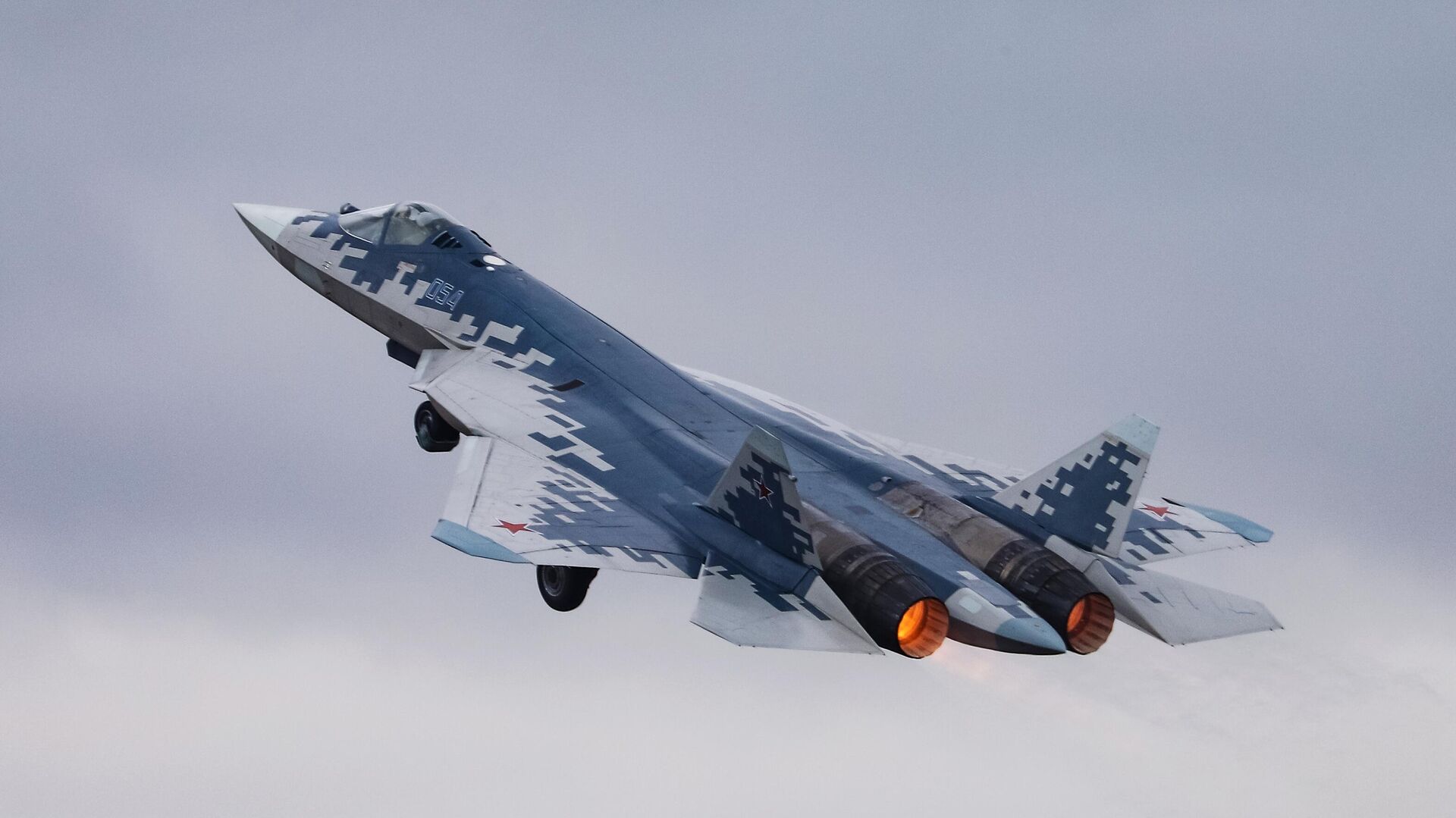https://sputniknews.in/20250529/does-the-iafs-fleet-truly-need-a-stealth-fighter-to-dominate-the-skies-9209097.html
Does the IAF's Fleet Truly Need a Stealth Fighter to Dominate the Skies?
Does the IAF's Fleet Truly Need a Stealth Fighter to Dominate the Skies?
Sputnik India
India currently operates 4.5-generation warplanes, including the French-made Rafales and the Russian Su-30MKIs, but lacks a stealth fighter like its northern... 29.05.2025, Sputnik India
2025-05-29T20:31+0530
2025-05-29T20:31+0530
2025-08-12T19:51+0530
sputnik opinion
india
china
russia
indian air force (iaf)
people's liberation army (pla)
pakistan
islamabad
delhi
new delhi
https://cdn1.img.sputniknews.in/img/07e9/02/06/8743137_0:0:3145:1769_1920x0_80_0_0_412b033b9fdf2d557b054c34d5e88469.jpg
The Government of India tweaked its rules for the development of the country's next-generation fighter jet, Advanced Medium Combat Aircraft (AMCA), allowing private sector participation in the nation's most ambitious defence project earlier this week.Interestingly, if everything went according to the plan, serial production of the AMCA would only begin from 2034 onwards, something that has raised concerns among military veterans and geopolitical pundits in India.This is because neighbouring China, a country with which India shares a demarcated border spanning thousands of kilometers, has already inducted hundreds of stealth fighters in its Air Force while Pakistan, its Western foe, is reportedly on the verge of signing a deal with China to acquire fifth-generation aircraft.For the uninitiated, China has two fifth-generation stealth fighters in its armada of warplanes - the J-20 and the Shenyang J-35.China already operates approximately 300 J-20 combat aircraft, with around 60 such combat planes being added every year to the nation's air force. The country plans to enlarge the production of the J-20 to just about 100 annually and aims to have a thousand J-20s in the People's Liberation Army Air Force (PLAAF) by the end of this decade.With the J-35, China’s second stealth fighter unveiled in November 2024, the country became the second in the world to operate two functional fifth-generation aircraft after the US, which fields the F-35 and F-22 Raptor.Some reports suggest that China may offer at least a 50 percent discount to Pakistan for procuring its twin-engine, multirole fifth-generation fighter jet, the J-35.Additionally, Pakistan is getting increasing support from Turkiye to get first-hand knowledge of 5th-generation fighters, with an estimated 200 Pakistani personnel specialising in technology and engineering assisting the Turkish Aerospace Industries (TAI) in the Kaan aircraft project. For the record, KAAN is Ankara's maiden domestically developed fifth-generation fighter plane, whose first flight took place last year. Serial production of the combat jet is scheduled to commence in 2028.These developments have forced many aviation analysts to urge the Indian government to urgently procure stealth fighters from friendly nations like Russia.The urgency for the Indian Air Force to induct a fifth-generation fighter jet stems from both geopolitical pressures and the need to maintain technological parity, particularly following the 2025 Indo-Pak conflict, which exposed the rapidly evolving threat dynamics in the region, according to aviation commentator Harpreet Sidhu, who is currently employed with GlobalData Plc, a market intelligence firm specialising in Aerospace, Defenсe & Security.While the AMCA continues to be India's flagship indigenous stealth fighter program, its projected serial production timeline of 2034 means that India faces a critical capability gap over the next decade, a period during which adversaries are likely to make significant advances, he told Sputnik India.Of particular concern is credible intelligence suggesting that China may supply J-35 stealth jets to Pakistan, which, if realised, could significantly elevate Pakistan's aerial warfare capabilities and upset the current regional balance, the aerospace analyst highlighted.The lessons of the 2025 war have underscored the crucial role of air superiority, especially in a modern battlefield where standoff precision attacks and survivability against integrated air defense systems (IADS) are vital. Despite ongoing upgrades, India's fourth-generation fleet remains vulnerable in such contested environments, he underscored.If India opts to procure a fifth-generation fighter jet before the AMCA is ready, the Sukhoi Su-57 emerges as the most pragmatic and strategically aligned option. There are several compelling reasons behind this, the observer reckoned.To begin with, Russia's willingness to offer full-scale technology transfer, local production, and customisation sets it apart from most Western suppliers. This aligns well with India's long-term goals under 'Make in India' and 'Atmanirbhar Bharat', allowing not just acquisition but also capability development, he underlined.Cost is another critical factor. The Su-57 is expected to be more affordable than Western stealth fighters like the F-35, particularly when local manufacturing is considered. Furthermore, a partnership with Russia is likely to come without restrictive end-user agreements or geopolitical strings, unlike deals with the US that involve End Use Monitoring Agreement (EUMA) or Communications Compatibility and Security Agreement (COMCASA) clauses, offering India greater strategic autonomy, the expert noted.However, there are valid concerns that must be addressed. The Su-57's operational deployment remains limited, and aspects like the development of the Izdeliye 30 engine and full sensor integration are still in progress. Russia’s recent logistical challenges during the Ukraine conflict also highlight possible issues with long-term support.It's also important to reflect on India's past experience with the Fifth Generation Fighter Aircraft (FGFA) programme, a joint effort based on the Su-57, which was shelved in 2018, Sidhu stressed.
https://sputniknews.in/20250529/india-to-build-5-prototypes-under-5th-gen-amca-fighter-jet-project---mod-9208271.html
india
china
russia
pakistan
islamabad
delhi
new delhi
beijing
moscow
Sputnik India
feedback.hindi@sputniknews.com
+74956456601
MIA „Rossiya Segodnya“
2025
Pawan Atri
https://cdn1.img.sputniknews.in/img/07e6/0c/13/139630_147:0:831:684_100x100_80_0_0_8fa2b25903e7787fe6a2698552c167df.png
Pawan Atri
https://cdn1.img.sputniknews.in/img/07e6/0c/13/139630_147:0:831:684_100x100_80_0_0_8fa2b25903e7787fe6a2698552c167df.png
News
en_IN
Sputnik India
feedback.hindi@sputniknews.com
+74956456601
MIA „Rossiya Segodnya“
Sputnik India
feedback.hindi@sputniknews.com
+74956456601
MIA „Rossiya Segodnya“
Pawan Atri
https://cdn1.img.sputniknews.in/img/07e6/0c/13/139630_147:0:831:684_100x100_80_0_0_8fa2b25903e7787fe6a2698552c167df.png
india, china, russia, indian air force (iaf), people's liberation army (pla), pakistan, islamabad, delhi, new delhi, beijing, moscow, su-57 fighter, su-57e, advanced medium combat aircraft (amca)
india, china, russia, indian air force (iaf), people's liberation army (pla), pakistan, islamabad, delhi, new delhi, beijing, moscow, su-57 fighter, su-57e, advanced medium combat aircraft (amca)
Does the IAF's Fleet Truly Need a Stealth Fighter to Dominate the Skies?
20:31 29.05.2025 (Updated: 19:51 12.08.2025) India currently operates 4.5-generation warplanes, including the French-made Rafales and the Russian Su-30MKIs, but lacks a stealth fighter like its northern adversary, China.
The Government of India tweaked its rules for the development of the country's next-generation fighter jet, Advanced Medium Combat Aircraft (AMCA), allowing private sector participation in the nation's most ambitious defence project earlier this week.
Interestingly, if everything went according to the plan, serial production of the AMCA would only begin from 2034 onwards, something that has raised concerns among military veterans and geopolitical pundits in India.
This is because neighbouring China, a country with which India shares a demarcated border spanning thousands of kilometers, has already
inducted hundreds of stealth fighters in its Air Force while Pakistan, its Western foe, is reportedly on the verge of signing a deal with China to acquire fifth-generation aircraft.
For the uninitiated, China has two fifth-generation stealth fighters in its armada of warplanes - the J-20 and the Shenyang J-35.
China already operates approximately 300 J-20 combat aircraft, with around 60 such combat planes being added every year to the nation's air force. The country plans to enlarge the production of the J-20 to just about 100 annually and aims to have a thousand J-20s in the People's Liberation Army Air Force (PLAAF) by the end of this decade.
With the J-35, China’s second stealth fighter unveiled in November 2024, the country became the second in the world to operate two functional fifth-generation aircraft after the US, which fields the F-35 and F-22 Raptor.
Some reports suggest that China may offer at least a 50 percent discount to Pakistan for procuring its twin-engine,
multirole fifth-generation fighter jet, the J-35.
Additionally, Pakistan is getting increasing support from Turkiye to get first-hand knowledge of 5th-generation fighters, with an estimated 200 Pakistani personnel specialising in technology and engineering assisting the Turkish Aerospace Industries (TAI) in the Kaan aircraft project.
For the record, KAAN is Ankara's maiden domestically developed fifth-generation fighter plane, whose first flight took place last year. Serial production of the combat jet is scheduled to commence in 2028.
These developments have forced many aviation analysts to urge the Indian government to urgently procure stealth fighters from friendly nations like Russia.
The urgency for the Indian Air Force to induct a fifth-generation fighter jet stems from both geopolitical pressures and the need to maintain technological parity, particularly following the 2025 Indo-Pak conflict, which exposed the rapidly evolving threat dynamics in the region, according to aviation commentator Harpreet Sidhu, who is currently employed with GlobalData Plc, a market intelligence firm specialising in Aerospace, Defenсe & Security.
While the AMCA continues to be India's flagship indigenous stealth fighter program, its projected serial production timeline of 2034 means that India faces a critical capability gap over the next decade, a period during which adversaries are likely
to make significant advances, he told
Sputnik India.
"China, for instance, has already fielded operational fifth-generation fighters like the J-20 and the J-35, with confirmed deployments in Tibet and Xinjiang. These aircraft provide the nation with key advantages in stealth, sensor fusion, and beyond-visual-range combat, shifting the balance of power in contested airspace," Sidhu said.
Of particular concern is credible intelligence suggesting that China may supply J-35 stealth jets to Pakistan, which, if realised, could significantly elevate Pakistan's aerial warfare capabilities and upset the
current regional balance, the aerospace analyst highlighted.
The lessons of the 2025 war have underscored the crucial role of air superiority, especially in a modern battlefield where standoff precision attacks and survivability against integrated air defense systems (IADS) are vital. Despite ongoing upgrades, India's fourth-generation fleet remains vulnerable in such contested environments, he underscored.
"Therefore, the need to induct a fifth-generation fighter is not merely about matching numbers but about safeguarding strategic deterrence. Until the AMCA is ready, India must consider an interim stealth solution to ensure its skies remain secure in an increasingly hostile and technologically competitive neighborhood," Sidhu emphasised.
If India opts to procure a fifth-generation fighter jet before the AMCA is ready, the Sukhoi Su-57 emerges as the most pragmatic and strategically aligned option. There are several compelling reasons behind this, the observer reckoned.
To begin with, Russia's willingness to offer full-scale technology transfer, local production, and customisation sets it apart
from most Western suppliers. This aligns well with India's long-term goals under 'Make in India' and 'Atmanirbhar Bharat', allowing not just acquisition but also capability development, he underlined.
"Plus, the Indian Air Force already operates a sizeable fleet of Russian-origin platforms, especially the Su-30MKIs, which share a design lineage with the Su-57. This commonality would simplify integration, logistics, maintenance, and pilot training," Sidhu explained.
Cost is another critical factor. The Su-57 is expected to be more affordable than Western stealth fighters like the F-35, particularly when local manufacturing is considered. Furthermore, a partnership with Russia is likely to come without restrictive end-user agreements or geopolitical strings, unlike deals with the US that involve End Use Monitoring Agreement (EUMA) or Communications Compatibility and Security Agreement (COMCASA) clauses, offering India greater strategic autonomy, the expert noted.
However, there are valid concerns that must be addressed. The Su-57's operational deployment remains limited, and aspects like the development of the Izdeliye 30 engine and full sensor integration are still in progress. Russia’s recent logistical challenges during the Ukraine conflict also highlight possible issues with long-term support.
It's also important to reflect on India's past experience with the Fifth Generation Fighter Aircraft (FGFA) programme, a joint effort based on the Su-57, which was shelved in 2018, Sidhu stressed.
"If a fifth-generation interim solution is pursued, the Su-57 remains the frontrunner due to its tech transfer potential, ecosystem compatibility, and strategic alignment with India's defence industrial base. However, a rigorous technical evaluation and phased induction—possibly under a restructured FGFA-like program—will be crucial to ensure the platform meets India's long-term combat needs," he concluded.



